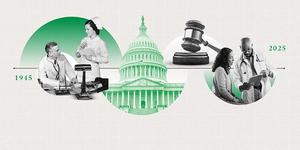PRINCETON, NJ -- Most observers now say that with Sen. John McCain's victories in Virginia, Maryland, and the District of Columbia on Tuesday, he is all but certain to be the Republican nominee this year, based on mathematical calculations of the number of GOP delegates necessary to gain the nomination.
But Mike Huckabee continues to campaign vigorously against McCain, and the news media spend a substantial amount of time highlighting the alleged rifts within the Republican Party in terms of conservative unwillingness to support McCain as their party's nominee.
Gallup Poll Daily election tracking makes it possible to place McCain's current status as his party's presumptive nominee in historical perspective by providing the basis for a comparison to the support other front-runners have enjoyed in previous elections.
At some point in every election, once a party's nominee is essentially known and agreed upon, Gallup has quit asking members of that party about the nomination process and has moved to asking about the general election. So the "final" nomination survey each election year serves as an interesting indicator of the overall support level that nominee was receiving among members of his party at the time he was deemed (by Gallup editors at any rate) to have the nomination sewn up.
McCain is not quite yet at that point. But the analysis of where previous front-runners were when they were assumed to have the nomination in hand provides a framework to use in calibrating just how "wounded" a nominee McCain may be. At this point, it can be said that while McCain's current 51% support for his presumptive candidacy is not overwhelming based on Gallup's historical record, it is not unprecedentedly low either. And there is still room for McCain to improve his standing in the days ahead.
Here are some year-by-year examples of where things stood in previous elections:
2004
Gallup's last 2004 primary-nomination survey in which the Democratic candidates were pitted against one another was conducted Feb. 16-17. In that survey, John Kerry (who at that point was the presumptive nominee) received 64% of the vote, to John Edwards' 18%. Incumbent President George W. Bush was unchallenged for the GOP nomination.
2000
Gallup's last primary-nomination survey for both parties in 2000 was conducted Feb. 25-27. Al Gore, who as incumbent vice president was all but assured of getting the nomination but who had some primary opposition, ended up in that final survey with 65% of the vote to Bill Bradley's 28%. On the Republican side, despite having been the leading Republican to get his party's nomination extending well back into 1999, George W. Bush was receiving a relatively modest 57% of Republican support. Who was in second place? None other than McCain, who at 34% actually had a slightly higher level of Republican support than Huckabee does now.
1996
Bob Dole, the eventual GOP nominee in 1996, had 58% of the Republican vote in Gallup's last primary survey of that year, conducted March 8-10. Pat Buchanan and Steve Forbes trailed, both with 15% of the GOP vote. Bill Clinton was the incumbent Democratic president seeking re-election.
1992
Clinton had 71% of the Democratic vote in Gallup's final primary survey of 1992, conducted March 20-22; Jerry Brown received 25%. On the Republican side, incumbent President George H.W. Bush received 86%, with Buchanan behind at 11% (the final GOP nomination survey in 1992 was conducted March 11-12).
1988
Michael Dukakis was at 69% of the vote in Gallup's final primary Democratic primary poll in 1988, conducted May 13-15, with Jesse Jackson second at 21%. On the Republican side, George H.W. Bush was in the lead by a virtually identical margin, 69% to 22% over Dole at the time of Gallup's last Republican primary poll, March 10-12.
1984
Gallup's last primary survey in 1984 was conducted May 18-21 -- even later than the final survey of 1988 -- and showed that Walter Mondale (who won the nomination) was ahead of Gary Hart by a relatively small margin, 46% to 34%, with Jackson at 10%. (Mondale's 46% was the lowest margin by any nominee in the final Gallup survey from 1980 through 2004.) Ronald Reagan was the incumbent president running for re-election on the GOP side and was not seriously challenged.
1980
Gallup's final primary nomination survey of 1980 was conducted Feb. 29-March 3. Reagan received 55% of the vote in that survey, followed by George H.W. Bush (the man who became his vice president) with 25%. Jimmy Carter was the Democratic incumbent seeking re-election.
Implications
These data show that at 51%, McCain's current support level is relatively low compared with the support that presumptive nominees in either party have enjoyed since 1980 at the time Gallup finished its primary polling. In fact, only Mondale in 1984 had a lower level of support in the final Gallup survey.
Surveying over the next several days will show whether McCain's support picks up after news of his three wins on Tuesday -- or whether it drops, given the news that Huckabee did well in Virginia among religious, conservative Republicans. If McCain's support climbs to at least 55%, then he will at least be able to say that his support is where Ronald Reagan's was in 1980 at the point when he was assumed to have won his party's nomination.
Survey Methods
The results showing John McCain's current standing are based on combined data from Feb. 10-12, 2008, including interviews with 1,002 Republican and Republican-leaning voters. For results based on this sample, the maximum margin of sampling error is ±3 percentage points.
The results for the various primary nominations from 1980 through 2004 discussed in this article are based on Gallup Polls conducted in each of those years on the dates indicated in the text. The sample sizes and sampling error associated with each vary from poll to poll.
In addition to sampling error, question wording and practical difficulties in conducting surveys can introduce error or bias into the findings of public opinion polls.
